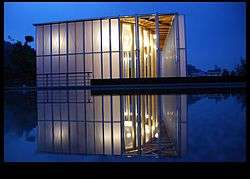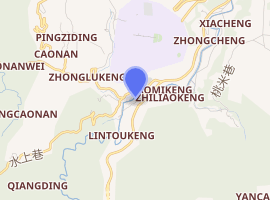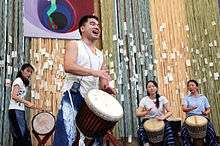Paper Dome
The Paper Dome (Chinese: 桃米紙教堂; pinyin: Táomǐ Zhǐ Jiàotáng)[1] is a temporary church building constructed using paper tubes as structural elements. It was designed on a pro-bono basis by Shigeru Ban, internationally known Japanese architect who is renowned for his paper tube structures and buildings. This temporary structure was built on September 17, 1995 to serve as a temporary church for Takatori Catholic Church after the Great Hanshin earthquake. Nonetheless, the venue was not only limited for use to religious worship but also used as a place for communal gatherings. However, when the church community planned to build a permanent building, the structure was donated to Taomi Village[2] in Puli Township, Nantou County, Taiwan which had suffered the 921 earthquake in 1999. The deconstructed structure was shipped in 2006 to Taiwan, reconstructed there and is now one of the top tourist attractions in that area.
| Paper Dome | |
|---|---|
桃米紙教堂 | |
 | |

| |
| Location | Puli, Nantou County, Taiwan |
| Architecture | |
| Architect(s) | Shigeru Ban |
| Architectural type | Church |
| Completed | 2008 |
History
In January 1995 Japan suffered from the Great Hanshin earthquake. 60% of all buildings were destroyed in Kobe, the epicentre of the disaster, including the Takatori Catholic church. However, strangely a statue of Jesus remained unharmed. People understood this fact as a miracle and they decided to rebuild the church as soon as possible. An internationally known Japanese architect Shigeru Ban was invited to build a temporary church for survivors.
Shigeru Ban is famous for his passion for using paper material in his projects. Indeed, paper although seemingly soft and non-effective for building, can actually be strong and trustful if used in the right way. Moreover, it is cheap, light and recyclable. Shegeru Ban is also known for his humanistic beliefs and social orientation. He built shelters for refugees in Africa and South America. There he noticed that cheap plastic shelters were too cold for people and it was more appropriate to use paper shelters.
Shigeru Ban created an ellipse-shape construction built from 58 cardboard tubes. 160 volunteers helped to build it and it took only five weeks to finish the project. The temporary church was nicknamed "Paper Dome". Paper Dome[3] became not only the new religious centre but a place of mutual help and support. It played the role of a community meeting place connecting Kobe residents.

But after 10 years it became apparent that the building was too small and that it had to be replaced by a new permanent church. Paper Dome was supposed to be destroyed. Luckily the president of New Homeland Foundation[4] visited Kobe. He knew that the Paper Dome’s mission in Kobe was over and he suggested donating the Paper Dome to the Taomi community as a symbol of friendship between Japan and Taiwan. Japan and Taiwan, two places which both suffer from earthquakes a lot, used to help each other and send their volunteers whenever a disaster happened The Paper Dome that was built after Great Hanshin earthquake had to continue its mission in Taomi, the place that was heavily damaged by the 921 earthquake in Taiwan.
On 29 May 2005 the last service was held in the Paper Dome[5] in Kobe and then the building was sent to Taiwan. After three years of formalities Taomi became the new home for Paper Dome. On 25 May 2008 over 1000 people participated in lifting cardboard tubes and witnessed the rebirth of the Dome.
Eventually the Paper Dome was opened for visitors on the next day after nine years 921 earthquake anniversary. On 21 September 2008 the delegates of two religious communities, Christianity and Daoism, got together to bless the land. Since this day the Paper Dome in Taomi is not only a tourist attraction but also a platform to exchange earthquake reconstruction experience and to educate people. Music performances, art exhibitions of local artists, weekend bazaars and other activities are held here.
Structure
From the cylindrical columns to the internal benches, Paper Dome is a giant hollow paper tube structure supported by a total of 58 tubes, 5 meters in height. The diameter of tube is about 33 centimetres and the thickness of paper is about 1.5 centimeters. It is built in a nomadic style which facilitated its dismantlement before its shift from Japan to Taiwan. The 58 tubes, together with the internal benches, are coated with an external water-resistant paper protective covering made in Puli Township, which is famous for its paper factories. Although each paper tube bench weighs no more than 60 kg, they are able to support weight up to 1500 kg each, equivalent to the weight of 20 people. As for the tall paper pillars, they are able to support pressure up to 6900 kg. The church is held up by 58 paper columns and even the bench chairs in the church are made using paper. This was designed to convey the message that materials as soft as paper can hold up a building; the roof, exterior and even the rectangular corridors are both made of fiber-reinforced plastics and sunshine shoots through the roof to present a sacred atmosphere for the church.
Appearances on TV
The building is features briefly in the Hong Kong television series Young Charioteers, which was filmed in Taiwan.
References
- "Paper Dome". paperdome.blogspot.com. Retrieved 10 November 2019.
- "Archived copy". Archived from the original on 5 August 2011. Retrieved 11 July 2011.CS1 maint: archived copy as title (link)
- "紙教堂 新故鄉見學園區 Paper Dome". paperdome.homeland.org.tw. Retrieved 10 November 2019.
- "首頁". 新故鄉文教基金會. Retrieved 10 November 2019.
- http://paperdome.homeland.org.tw/pd/
External link
![]()